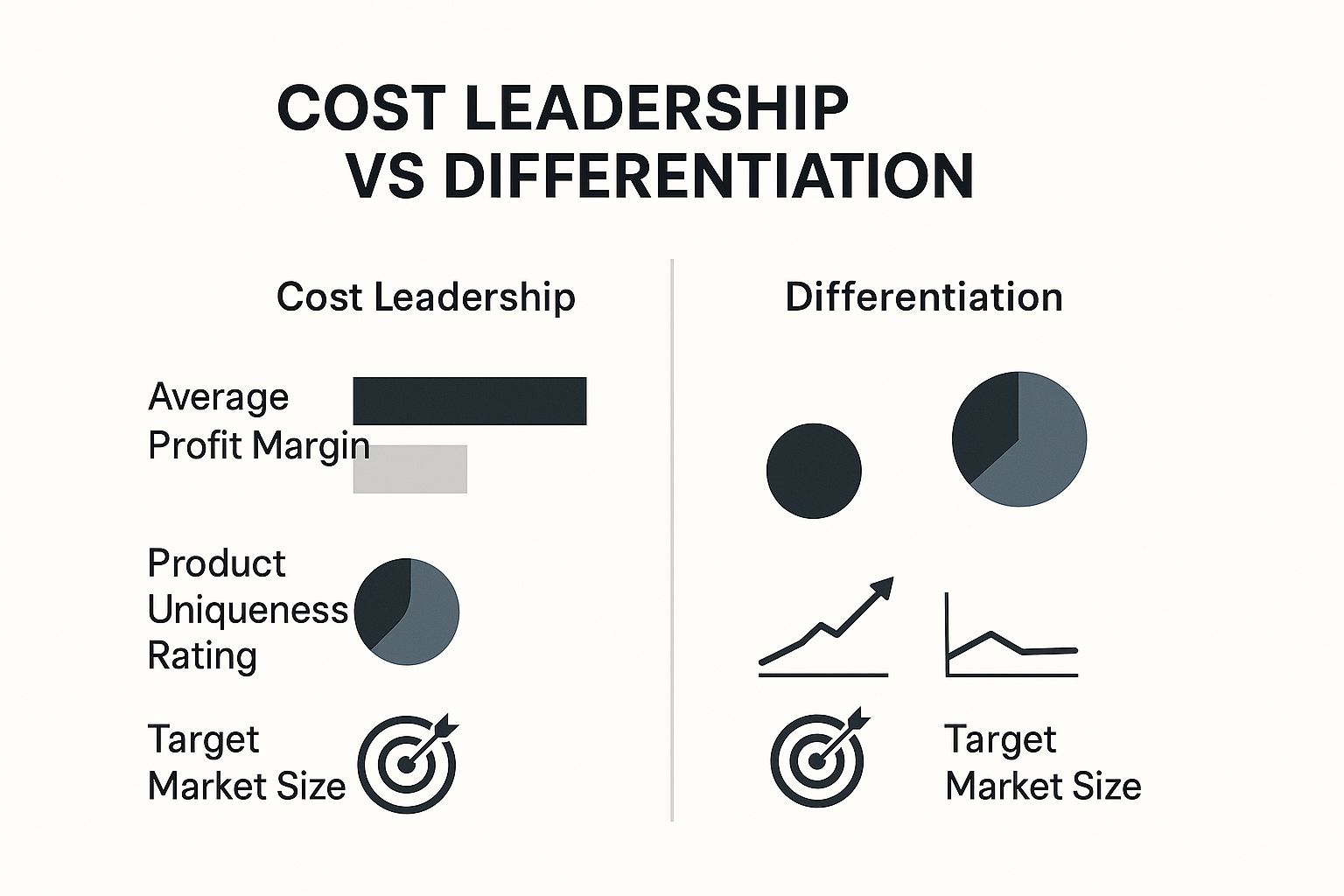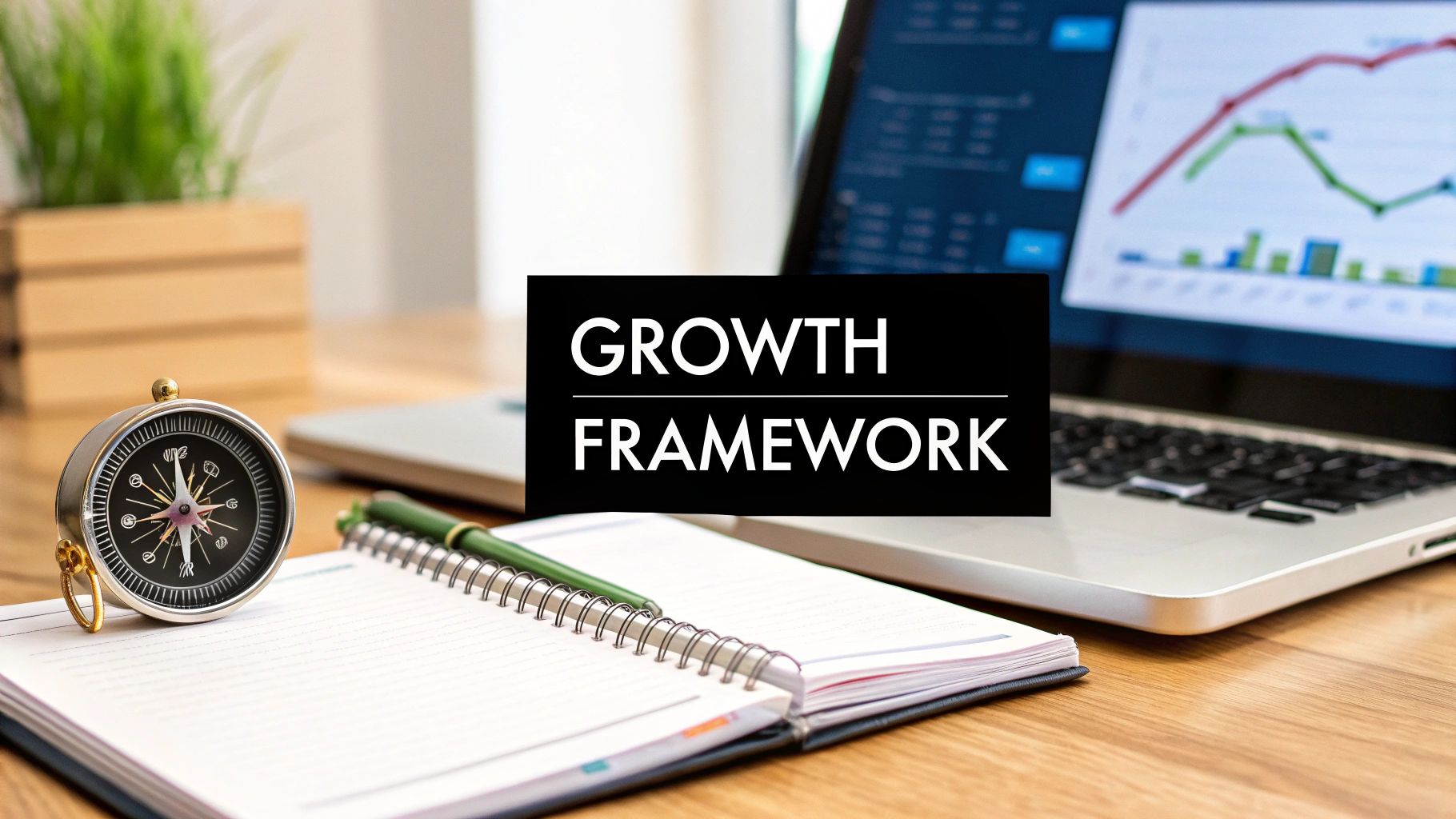A growth strategy framework is essentially a repeatable system that guides how your business grows. Think of it less as a rigid set of rules and more like a GPS for your company's expansion. It helps you move past vague goals like "get more customers" and provides a clear, data-informed roadmap to get there.
What Is a Growth Strategy Framework
Have you ever tried to assemble complex furniture without the instructions? You have all the pieces—the screws, the panels, the little Allen key—but no clear idea how they fit together. The end result is usually wobbly, unstable, and definitely not what you saw in the showroom.
Running a business without a growth framework is a lot like that. You can throw money at marketing campaigns, hire more salespeople, or launch new features, but without a coherent plan, these efforts are often disconnected and the results are completely unpredictable.
A growth framework is the instruction manual your business needs. It’s a structured system that gets your entire team on the same page about what really drives growth, how to measure it, and most importantly, how to repeat what works. This isn't about creating a single, static plan. It's about building a consistent process for finding, testing, and scaling good ideas.
Beyond Random Acts of Growth
At its core, a growth framework is designed to swap guesswork for a systematic, repeatable process. So many businesses fall into the "random acts of growth" trap—they hear about a new marketing trend, see a competitor trying something, and immediately jump on the bandwagon without really understanding why. This approach just burns through time and money.
A solid framework forces you to ask the tough questions first:
- What’s our main objective right now? Is it acquiring new users, keeping the ones we have, or increasing revenue from them?
- How will we know if we’re succeeding? Which key performance indicators (KPIs) actually matter?
- Which ideas should we test first? How do we prioritize what could have the biggest impact with the least effort?
- What’s our process for learning? How do we take what we learn from experiments—good or bad—and use it to get better?
Answering these questions brings much-needed focus and discipline to your efforts.
A growth framework doesn't guarantee every idea will be a winner. Instead, it guarantees you'll learn something valuable from every experiment, win or lose, and compound that knowledge over time.
This structured thinking is what truly separates companies that scale quickly from those that just spin their wheels. It creates a shared language that marketing, product, sales, and engineering can all understand, making sure everyone is rowing in the same direction.
For example, instead of the marketing team chasing leads while the product team builds features in a silo, a framework like AARRR encourages them to work together on the entire customer lifecycle—from the moment a user first hears about you to the point where they're recommending you to friends. That unified focus is the real engine of sustainable growth.
Now, let's look at a few of the most popular frameworks teams use to build this kind of system. Each has a slightly different focus, but they all share the goal of creating a methodical approach to expansion.
Quick Overview of Key Growth Frameworks
| Framework | Primary Focus | Key Components/Stages |
|---|---|---|
| AARRR (Pirate Metrics) | Optimizing the entire customer funnel. | Acquisition, Activation, Retention, Referral, Revenue |
| North Star Metric | Aligning the entire company around a single key metric. | Identifying one metric that best captures the core value delivered to customers. |
| ICE Scoring | Prioritizing growth experiments effectively. | Impact, Confidence, Ease |
| Growth Loops | Creating self-sustaining growth cycles. | Actions from one user cohort generate new users (e.g., viral, content, or paid loops). |
These models provide the scaffolding you need to stop guessing and start building a predictable growth engine. Whether you're aligning your team with a North Star Metric or prioritizing ideas with an ICE score, the goal is the same: make smarter decisions, faster.
Building a Resilient Framework for Global Markets

A powerful growth strategy framework can't be built in a vacuum. Your business doesn’t operate in a sterile lab; it’s out in the wild, exposed to the unpredictable currents of the global economy, sudden supply chain shocks, and shifting geopolitical tides. Any plan that’s too rigid will simply snap under that kind of pressure.
The most effective growth systems are designed for resilience. Think of it like building a suspension bridge instead of a solid stone arch. The suspension bridge is engineered to flex and sway with the wind and the weight of traffic, making it stronger—not weaker—under stress. A resilient growth strategy framework does the exact same thing for your business.
This means you have to look beyond your internal metrics and start baking external realities right into your planning. It’s about creating an adaptable system that can absorb shocks and even flip potential threats into strategic opportunities. This requires a proactive stance, not a reactive one.
Assessing External Risks and Opportunities
The first step in building real resilience is to look outward. Your framework absolutely must account for economic and political factors that are completely outside your control but have a direct impact on your operations and market demand. A robust system is always scanning the horizon for these variables.
Key external factors to build into your framework include:
- Regional Economic Shifts: A market that’s booming one year could be heading for a downturn the next. Your strategy needs the agility to shift resources to more promising regions when that happens.
- Supply Chain Vulnerabilities: The pandemic showed everyone just how fragile global supply chains can be. A resilient framework identifies potential bottlenecks and builds in redundancies or alternative sourcing options well in advance.
- Global Trade Tensions: Tariffs and trade disputes can suddenly crush your margins or close off entire markets. For any company with international ambitions, planning for these scenarios is non-negotiable.
Ignoring these elements is like setting sail without checking the weather. Sure, you might enjoy clear skies for a while, but you’ll be completely unprepared when the storm inevitably hits.
The Role of Scenario Planning
Scenario planning is the tool you use to build this resilience. It’s all about creating several plausible future scenarios—think optimistic, pessimistic, and somewhere in the middle—and outlining exactly how your business would respond to each one. This isn't about predicting the future with a crystal ball; it's about preparing for a range of possibilities.
A resilient growth framework isn't a fixed map to a single destination. It's a high-tech compass that helps you navigate toward your goal, no matter how much the terrain shifts beneath your feet.
For instance, a SaaS company might model what happens if there’s a sudden economic slowdown in a key market, or if a new, heavily funded competitor enters the space. By thinking through these "what-ifs" ahead of time, the team can develop contingency plans, identify trigger points for action, and avoid making panicked decisions under pressure.
This forward-looking approach transforms your growth strategy from a static document into a living, breathing system that adapts to the world as it is, not just as you wish it would be.
Adapting to a Complex Global Economy
The need for this kind of adaptability is clearer than ever. Projections for 2025 show a tangled global economic picture where growth is uneven and risks are high. While overall global GDP growth is expected to hold steady, that number hides massive regional differences. The United States continues to show strong demand, the eurozone is facing stagnation, and China’s growth is forecasted to slow. This fractured landscape, complicated by geopolitical tensions, demands a truly nuanced growth strategy framework. You can discover more details on the economic outlook for 2025 and its strategic implications.
A business stuck with a one-size-fits-all approach would get battered in this environment. But a company with a resilient framework can make proactive pivots. It might double down on its US marketing while scaling back in Europe, or it might explore emerging markets that show stronger growth potential despite the risks.
By integrating risk assessment and scenario planning directly into its core, a business can navigate volatility with confidence. This is the hallmark of a truly powerful growth strategy—not just planning for growth, but building a system that is prepared for anything.
The Core Components of a Modern Growth Strategy

Let's move past the theory. A modern growth strategy isn't some dusty document you write once and file away. It’s a living, breathing system made up of several key parts that work together. To build a plan that can actually handle market swings and deliver real results, you have to get your hands dirty and ground it in what’s actually happening on the ground.
This means building a growth strategy framework that accounts for everything from unpredictable input costs to the ever-shifting regulatory landscape. A solid framework acts as the bridge between your big-picture goals and the daily tasks your teams are tackling. It’s a blueprint for making smarter decisions, ensuring every initiative, every dollar spent, and every product update moves you closer to sustainable growth. Without these core components, your strategy is just a collection of nice ideas with no real horsepower.
Grounding Strategy in Operational Truths
First things first: your strategy has to be based in reality. It’s that simple. Any plan that pretends rising energy costs, logistics headaches, or changing software prices don’t exist is set up to fail from the start. A truly modern framework doesn't ignore these operational and market truths—it puts them front and center.
This requires you to know your entire value chain inside and out. For example, if you depend on third-party APIs, what's your plan if they suddenly change their pricing? If you have customers around the world, how will currency fluctuations hit your bottom line? By baking these realities into your financial models and risk assessments, your strategy becomes far more resilient and believable.
A growth strategy that isn't connected to the operational and financial realities of the business is more of a wish list than a plan. True resilience comes from building on a foundation of facts, not assumptions.
Defining ROI-Driven Outcomes
Fuzzy goals like "grow our market share" just don't cut it anymore. A powerful framework is built on clear, time-bound outcomes that are directly tied to a return on investment (ROI). Every major project needs a specific, measurable objective linked to a financial result. This brings a ton of discipline and clarity, helping you zero in on the activities that will actually move the needle.
For instance, instead of a vague goal like "improve user engagement," aim for something concrete: "Increase the user activation rate by 15% in Q3, which we project will lead to a 5% lift in monthly recurring revenue." This level of detail makes it easy to track your progress and hold teams accountable for the outcomes. For more examples, check out our guide on marketplace growth strategies for ideas you can put into action.
Adopting Agile and Risk-Aware Models
Finally, the world moves too fast for rigid five-year plans. A winning growth strategy framework has to be agile, allowing you to pivot quickly as you learn new things. This means embracing agile ways of working, running small experiments to test your assumptions, and using that feedback to iterate and improve.
This nimble approach is balanced with a sharp eye for risk. A modern framework isn't just about chasing the upside; it's about actively spotting and neutralizing potential threats. One analysis showed how a forward-thinking UK company used this exact model to overhaul its supply chain before new legislation hit, saving them from a projected £2.3 million hit to their bottom line. This combination of data-driven agility and risk management is the key to building a growth engine that can scale and adapt, no matter what comes next.
A Deep Dive Into Popular Growth Frameworks
Once you've grasped why you need a growth strategy framework, the fun part begins: exploring the 'how.' There are several battle-tested models out there, and each one gives you a different way to look at and organize your growth initiatives. Think of them less as rigid rulebooks and more as complementary tools in your toolbox.
The best framework—or combination of them—really depends on your product, your market, and what you’re trying to achieve. For a more focused look at strategic planning, you might also find it helpful to explore how these same principles can be used to build a powerful content strategy framework.
AARRR Pirate Metrics: Charting The Customer Funnel
Let’s start with arguably the most famous growth model: Dave McClure’s AARRR framework. It's famously nicknamed "Pirate Metrics" (say it out loud: A-A-R-R-R), and for good reason. It’s a brilliantly simple way to map out your customer’s entire journey across five key stages.
- Acquisition: How are people discovering you? This is all about your top-of-funnel channels, from organic search and paid ads to social media buzz.
- Activation: Was their first visit a good one? This is that critical "aha!" moment when a new user truly gets the value you offer. For a SaaS app, that might be when they create their first project.
- Retention: Do they keep coming back? This is where the real magic happens. Retention is a direct measure of the long-term value your product delivers.
- Referral: Do they love you enough to tell their friends? Happy customers can be your most powerful marketing engine. This stage tracks how well you turn users into advocates.
- Revenue: How does this all translate to making money? This is the bottom line, tracking things like users upgrading to a paid plan or making a purchase.
The real strength of AARRR is its clarity. It forces you to look at the whole customer lifecycle and pinpoint exactly where the leaks are. If acquisition is low, your marketing might need a rethink. If retention is poor, the problem might lie with the product itself.
The North Star Metric: Your Company's Compass
While AARRR gives you a map of the journey, the North Star Metric (NSM) framework gives you a destination. The concept is simple: your company should rally around one single, overarching metric that best captures the core value you provide to your customers.
For a collaboration tool like Slack, the NSM might be "Weekly Active Teams" because that number reflects deep engagement. For an e-commerce platform like Shopify, it could be the "Total Number of Active Merchants."
The North Star Metric acts as a company's compass. It ensures that every team—from product and marketing to sales and support—is aligned and moving in the same direction, making decisions that contribute to what truly matters for customer success.
When everyone is working to move the same number, it breaks down silos and stops teams from chasing conflicting goals. It’s a powerful way to create alignment.
ICE Scoring: The Prioritization Power Tool
Once you have a framework like AARRR or a North Star Metric, your team will be buzzing with ideas. The new challenge? Deciding what to tackle first. That's where the ICE scoring model shines. It's a straightforward system for prioritizing your backlog of growth experiments.
Each idea is rated on three simple criteria:
- Impact: If this works, how big of a difference will it make? (Score 1-10)
- Confidence: How sure are we that this idea will actually work? (Score 1-10)
- Ease: How much time and effort will this take to implement? (Score 1-10)
You average the scores to get a final ICE score for each idea, and the ones with the highest scores bubble up to the top of your list. It replaces gut feelings and loud opinions with a more data-informed way of deciding where to put your resources.
Comparison of Top Growth Strategy Frameworks
To help you decide which model might fit your business best, here’s a quick comparison of the three frameworks we just covered. Remember, you can also blend these approaches to create a custom system that works for you.
| Framework | Best For | Core Concept | Key Benefit | Potential Drawback |
|---|---|---|---|---|
| AARRR | Startups and teams needing to diagnose funnel health. | Breaking the customer journey into 5 measurable stages. | Provides a holistic view of the customer lifecycle and identifies weak points. | Can sometimes feel too linear; stages often overlap in reality. |
| North Star | Mature businesses aiming for company-wide alignment. | Defining one single metric that represents core customer value. | Aligns all teams and departments toward a single, unified goal. | Difficult to identify the "perfect" metric; can oversimplify complex businesses. |
| ICE Score | Growth teams with a large backlog of ideas. | Prioritizing experiments based on Impact, Confidence, and Ease. | Offers a simple, data-informed system for making quick decisions. | Can be subjective; relies on team estimates rather than hard data. |
Choosing the right framework is about finding the right lens to view your growth challenges. AARRR helps you see the whole picture, the North Star Metric keeps everyone focused, and ICE helps you decide what to do next.
This infographic compares two fundamental strategic approaches, Cost Leadership and Differentiation, showing how they influence key business metrics.
 The visualization highlights the trade-off between targeting a broad market with lower margins and serving a niche market with highly unique, profitable products.
The visualization highlights the trade-off between targeting a broad market with lower margins and serving a niche market with highly unique, profitable products.
How to Adapt Your Strategy for Emerging Markets

When you’re looking to expand, a rigid growth strategy framework isn't just unhelpful—it's a liability. What brought you success in a stable, mature economy can completely miss the mark in an emerging market. The rules of the game are just different. These markets aren't one big, uniform opportunity; they're a complex and dynamic mix of incredible potential and unique challenges that demand a flexible, on-the-ground approach.
One-size-fits-all strategies simply don't work because they bulldoze right over the distinct economic realities, consumer habits, and even political landscapes that define these regions. To succeed, you have to treat your core framework less like a rigid blueprint and more like a compass—a tool for navigating uncertainty, not a plan that shatters under pressure. It's all about tailoring your approach to fit what’s actually happening on the ground.
The real secret is shifting from a global plan to a series of regional playbooks. You have to dig into each market's specific dynamics, from its regulatory quirks to its cultural norms, and adjust your strategy accordingly. This customization is what separates the businesses that thrive from those that just barely hang on.
Differentiating Your Approach Across Regions
Let's be clear: not all emerging markets are the same. Latin America, Southeast Asia, and Eastern Europe each move to their own economic rhythm and come with their own set of geopolitical risks. A truly adaptive growth strategy framework has to account for these massive differences. A marketing campaign that crushes it in Brazil might fall completely flat in Vietnam, simply due to cultural nuances and totally different ways people consume media.
As you localize your strategy, think about these factors:
- Economic Conditions: What’s the local GDP growth, inflation rate, and currency stability? In a high-inflation environment, you might need entirely different pricing models or payment options.
- Consumer Behavior: How do local customers actually find, research, and buy things? In some regions, mobile-first shopping and social commerce aren't just trends—they're the only way to do business.
- Regulatory Landscape: You have to get smart about local laws on data privacy, taxes, and business operations. These rules can dramatically change your go-to-market plan and how much it costs to operate.
Adapting your strategy means localizing more than just your ad copy. It's about tweaking your entire business model, from product features to how you handle customer support. It requires a genuine respect for the local context and a readiness to learn and pivot.
Navigating Economic and Geopolitical Realities
Looking ahead is crucial for adapting your framework. Economic forecasts for emerging markets in 2025 really drive home how varied these regions are. Research suggests that overall GDP growth in emerging markets is expected to slow to 3.4%, thanks in large part to geopolitical tensions. For example, a trade dispute could slow growth in EM Asia to 4%, while Latin America might get a boost from Argentina’s economic rebound. With disparities like these, a uniform strategy is set up to fail.
A flexible framework is your key to turning volatility into an advantage. By anticipating regional economic shifts and geopolitical risks, you can proactively adjust your resources and focus, shielding your business from shocks while jumping on localized opportunities.
This data really highlights why a differentiated approach is non-negotiable. A company might need to rework its supply chain in Asia to sidestep trade risks while, at the same time, planning an aggressive expansion in Latin America to ride its stronger growth wave. For SaaS companies, this also means thinking about how local economic health will affect churn and tailoring your efforts to keep customers. Our detailed guide on SaaS customer retention strategies offers some valuable ideas here.
Ultimately, adapting your growth strategy framework for emerging markets is a constant cycle of watching, analyzing, and customizing. It’s about building a system that isn't just resilient to change but is designed to find growth within it.
Putting Your Growth Framework Into Action
Knowing about growth frameworks is one thing, but actually putting them to work is a whole different ball game. This is where theory gets its hands dirty. It’s the moment you take a growth strategy framework off the whiteboard and turn it into a real-world engine for your business.
So, let's walk through how to apply these models to a common SaaS challenge: building a successful affiliate marketing program. Without a solid structure, an affiliate program can quickly become a chaotic mess of partners, links, and payouts. Layering a framework on top brings order to that chaos, turning it into a predictable and scalable revenue channel.
Define Your Affiliate North Star
First things first: what does "success" actually look like for your affiliate program? Before you recruit a single partner, you need a clear answer. This is where the North Star Metric (NSM) framework is invaluable. It forces you to move beyond vague goals like "get more affiliates" and rally everyone around a single, specific metric that truly represents value.
For an affiliate program, a great NSM might be:
- Monthly Active Referred Users (MARU): This shifts the focus from the sheer quantity of sign-ups to the quality of the customers being referred.
- Total Referred Revenue: This is as direct as it gets, tying your program’s performance straight to the company's bottom line.
When you have a clear NSM, every decision—from how you recruit partners to how you structure commissions—is guided by the same ultimate goal.
Map the Affiliate Journey with AARRR
Once your North Star is set, you can use the AARRR model to break down and optimize the entire affiliate experience, from the moment they hear about your program to the revenue they generate. Think of it as a diagnostic tool that shows you exactly where things are working and where they're breaking down.
A framework transforms your affiliate program from a collection of individual partner relationships into a cohesive, measurable system. It allows you to see the entire journey and pinpoint exactly where to invest your efforts for the biggest returns.
Here’s how you can apply AARRR to your affiliate program:
- Acquisition: How are you finding and recruiting the right affiliates in the first place?
- Activation: What's the "aha!" moment for a new partner? Maybe it’s getting their first click, or better yet, earning their first commission.
- Retention: Are your best affiliates sticking around and promoting you month after month? Or are they churning?
- Referral: Are your top performers so happy that they recommend your program to other potential affiliates?
- Revenue: How much new business are your affiliates actually driving?
Looking at your program through these five stages is incredibly revealing. For example, if you have high acquisition but low activation, it’s a big red flag that your onboarding process is confusing or uninspiring. Our complete guide on SaaS affiliate marketing dives deeper into tactics for each of these stages.
Finally, bring in the ICE model to prioritize your experiments. You'll likely have a dozen ideas, like testing a new commission tier or creating fresh promotional assets. By scoring each idea on its potential Impact, your Confidence in it working, and the Ease of implementation, you can focus your limited resources on the tests most likely to move your North Star Metric. As you build your program, you can also explore broader strategies to make money online to see how your affiliate efforts fit into the bigger picture.
Have Questions About Growth Strategy? We Have Answers.
Even after you get the hang of the different models, jumping into a growth strategy framework can feel a bit daunting. Let's walk through a few of the most common questions that pop up, so you can move forward with confidence.
How Do I Choose the Right Framework for My Business?
Picking a growth strategy framework isn't about finding the one "best" model. It’s about finding the right fit for where your business is right now.
Think of it this way: The AARRR framework is brilliant for early-stage companies that need to figure out where they're losing customers. On the other hand, the North Star Metric is perfect for more established businesses trying to get every single team pulling in the same direction.
It’s like picking a vehicle for a trip. If you’re navigating tight city streets to find a specific address (like diagnosing a funnel leak), a nimble scooter (AARRR) is your best bet. If you’re trying to get a huge group of people to the same destination (aligning the company), you’ll need a bus (North Star Metric).
Start by pinpointing your single biggest growth challenge. Once you have that, the right framework usually becomes pretty obvious.
How Often Should We Revisit Our Growth Strategy?
Your growth strategy should be a living, breathing part of your business, not something you write once and file away. While your core framework might stay the same for a while, the tactics and priorities you set within it need constant attention.
A good rhythm is to check in on progress during weekly or bi-weekly growth meetings. Then, schedule a deeper, more strategic review quarterly.
This keeps you agile. The quarterly review is your opportunity to zoom out. Ask the big questions: Is our North Star Metric still the right one? Have market changes opened up new opportunities we should be chasing?
A growth strategy isn't a "set it and forget it" document. It’s a continuous loop of planning, doing, measuring, and learning. Regular check-ins ensure you’re reacting to real-time data, not just following an old map.
Do These Frameworks Only Work for SaaS Companies?
Not at all. While frameworks like AARRR became famous in the SaaS world, their core logic is universal.
Take an e-commerce store, for example. You can easily map its customer journey to AARRR:
- Acquisition: A customer clicks on your ad.
- Activation: They make their first purchase.
- Retention: They come back for another one.
- Referral: They share a discount code with a friend.
- Revenue: You track their total lifetime value.
It works for service businesses, too. A digital agency could set a North Star Metric like "Monthly Completed Projects" to measure client success. At their heart, these frameworks are all about creating a structured, measurable, and repeatable process for growth—and that applies to just about any business out there.
Ready to turn your growth strategy into a scalable, automated engine? Refgrow provides the embeddable affiliate platform to launch, manage, and scale your referral program in minutes, all within your own product. Start growing your business with Refgrow today.

